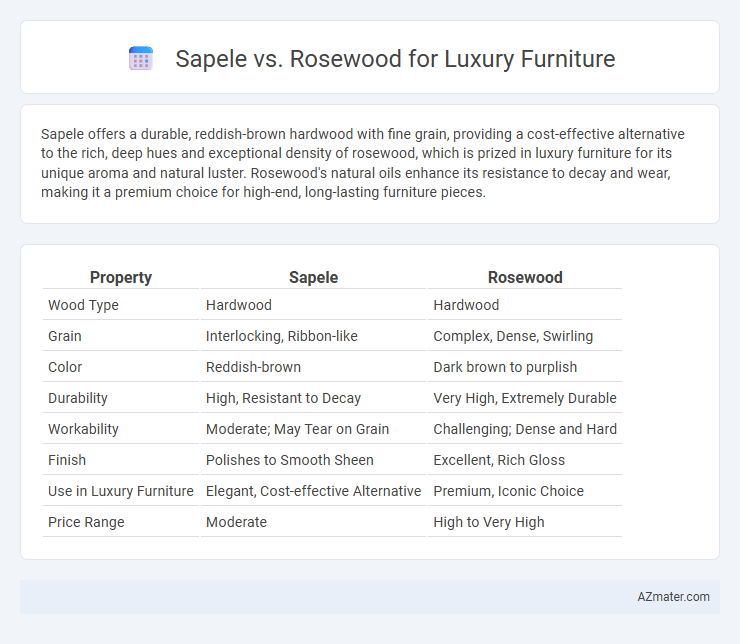Sapele offers a durable, reddish-brown hardwood with fine grain, providing a cost-effective alternative to the rich, deep hues and exceptional density of rosewood, which is prized in luxury furniture for its unique aroma and natural luster. Rosewood's natural oils enhance its resistance to decay and wear, making it a premium choice for high-end, long-lasting furniture pieces.
Table of Comparison
| Property | Sapele | Rosewood |
|---|---|---|
| Wood Type | Hardwood | Hardwood |
| Grain | Interlocking, Ribbon-like | Complex, Dense, Swirling |
| Color | Reddish-brown | Dark brown to purplish |
| Durability | High, Resistant to Decay | Very High, Extremely Durable |
| Workability | Moderate; May Tear on Grain | Challenging; Dense and Hard |
| Finish | Polishes to Smooth Sheen | Excellent, Rich Gloss |
| Use in Luxury Furniture | Elegant, Cost-effective Alternative | Premium, Iconic Choice |
| Price Range | Moderate | High to Very High |
Introduction to Sapele and Rosewood
Sapele and Rosewood are premium hardwoods widely used in luxury furniture due to their durability and rich aesthetic appeal. Sapele, a hardwood from the mahogany family native to Africa, features a deep reddish-brown color with a distinct interlocking grain that creates a ribbon-like effect. Rosewood, known for its complex grain patterns and natural oils, offers a dark, rich hue ranging from reddish-brown to deep purple, prized for both its visual beauty and resistance to wear.
Origins and Botanical Differences
Sapele, a hardwood native to West Africa, belongs to the Meliaceae family and is closely related to mahogany, characterized by its interlocking grain and reddish-brown hue. Rosewood, primarily sourced from Dalbergia species across Brazil, India, and Southeast Asia, is prized for its rich, dark tones and distinctive oily texture due to its dense cellular structure. Botanically, Sapele's uniform texture contrasts with Rosewood's natural luster and varied grain patterns, influencing durability and aesthetic appeal in luxury furniture craftsmanship.
Appearance and Grain Patterns
Sapele exhibits a rich reddish-brown hue with fine interlocking grain that often creates dramatic ribbon or chatoyant effects, making it ideal for luxury furniture with a vibrant, warm appearance. Rosewood is prized for its deep, dark brown to purplish tones and striking, straight to interlocked grain patterns that range from fine to coarse, offering a more opulent and exotic look. The distinctive grain complexity of Rosewood provides a luxurious texture that contrasts with Sapele's more uniform yet vividly patterned surface, influencing the aesthetic choice in high-end furniture design.
Color Variations and Aging
Sapele exhibits a rich reddish-brown hue with dark, interlocking grain patterns that deepen in color over time, enhancing its elegance for luxury furniture. Rosewood offers a more dramatic range of colors from deep purples to reddish-browns, and its natural oils cause it to darken and develop a polished patina with age. Both woods age gracefully, but rosewood's vibrant color changes and sapele's consistent maturation make them uniquely desirable for high-end cabinetry and furnishings.
Hardness and Durability
Sapele offers a Janka hardness of approximately 1,410 lbf, making it moderately hard and suitable for durable luxury furniture that resists dents and scratches over time. Rosewood, particularly Brazilian Rosewood, boasts a higher Janka hardness around 1,850 lbf, providing superior durability and resistance to wear, ideal for high-end, long-lasting pieces. Both woods exhibit excellent stability, but Rosewood's increased hardness translates to enhanced longevity in luxury furniture applications.
Workability and Machinability
Sapele offers excellent workability with its medium density and fine interlocked grain, making it easier to shape and carve compared to rosewood. Rosewood's higher density and oily texture provide superior machinability but require sharp tools and careful handling to avoid burning or chipping during fine woodworking. Both woods are prized in luxury furniture for their durability, but sapele's smoother machining process often appeals to craftsmen aiming for detailed designs and flawless finishes.
Acoustic Properties for Furniture
Sapele offers a warm, mid-range tonal quality with clear, balanced resonance, making it ideal for luxury furniture pieces that benefit from subtle acoustic enhancement. Rosewood provides superior sound projection and rich, complex harmonics, favored in high-end musical instrument cases and furniture that emphasizes sound clarity. Both woods exhibit excellent density and durability, but Rosewood's natural oily texture enhances acoustic performance by reducing vibrations and producing deeper bass tones.
Cost and Market Availability
Sapele offers a more affordable price point compared to Rosewood, making it a cost-effective choice for luxury furniture without compromising on durability and grain aesthetics. Rosewood is significantly more expensive due to its rarity and high demand, often driving prices up in both raw material and finished furniture markets. Market availability of Sapele is broader and more consistent, while Rosewood faces stricter regulations and limited supply, impacting its accessibility for luxury furniture manufacturers.
Sustainability and Environmental Impact
Sapele and Rosewood are both prized for luxury furniture, but Sapele offers a more sustainable option due to its faster growth rates and certification availability under FSC standards. Rosewood, often harvested from endangered species with limited legal trade, poses significant environmental concerns linked to deforestation and habitat loss. Choosing Sapele supports responsible forestry practices, reducing ecological impact while maintaining high-quality aesthetics and durability.
Which is Better for Luxury Furniture?
Sapele offers exceptional durability and a rich, reddish-brown hue that deepens over time, making it a popular choice for luxury furniture with a warm, elegant appearance. Rosewood is prized for its striking dark grain patterns and natural luster, providing a highly sophisticated and exotic look often associated with premium craftsmanship. For luxury furniture, rosewood is generally considered superior due to its unique aesthetics and rarity, though sapele remains a strong alternative for durability and affordability.

Infographic: Sapele vs Rosewood for Luxury Furniture
 azmater.com
azmater.com